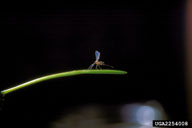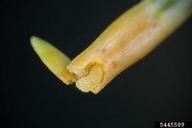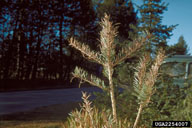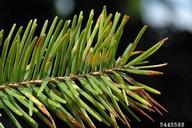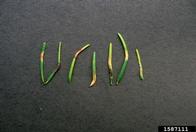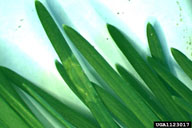Douglas-fir needle midge
Contarinia pseudotsugae Condrashoff (Diptera: Cecidomyiidae)
Orientation to pest
Douglas-fir needle midge, Contarinia pseudotsugae Condrashoff, is one of three species in this genus of native North American cecidomyiid flies that lay their eggs in developing needles of Douglas-fir (Pseudotsuga menziesii Mirb.). This is the most abundant of the three. It is a significant pest of Douglas-fir when it is grown as Christmas trees, particularly in the dry-belt of open-grown interior forests in the Pacific northwestern United States in California, Oregon, Washington, Idaho, Montana, and in British Columbia, Canada. Adults emerge from the soil in spring and lay eggs on needles. The larvae bore into needles to feed, causing their growth to be deformed. In the fall, mature larvae drop back into the soil to pupate and overwinter. Damaged needles bear small galls and heavily galled Christmas trees have lower market value. There is one generation of this fly per year.
Hosts commonly attacked
The only known host of this insect is Douglas-fir (P. menziesii).
Distribution
This species is of concern in the Pacific northwestern United States (California, Oregon, Washington, Idaho, Montana) and British Columbia, Canada, but is also found in Pennsylvania.
Images of Douglas-fir needle midge
| Figure 1. Adult of Douglas-fir needle midge, Contarinia pseudotsugae | Figure 2. Larva of Douglas-fir needle midge inside its gall, which has been cut | |
| Figure 3. Douglas-fir needles (left) showing injury due to Douglas-fir needle midge; and, right, damage in an earlier stage | Figure 4. Damage to Douglas-fir from Douglas-fir needle midge | |
Important biological control agents related to this pest species
No information is available on natural enemies of this species.
Web links for information on Douglas-fir needle midge
- Management Guide | USDA FHP and State Forestry Organizations
Provides information on recognition and biology - Article from Ornamentals Northwest Newsletter Archive | Oregon State University
Provides helpful information for determining a spray schedule for this pest - Christmas Tree Fact Sheet | Pennsylvania State University Extension
Articles
- Condrashoff, S. F. 1961. Three new species of Contarinia. (Diptera: Cecidomyiidae)in Douglas-fir needles. The Canadian Entomologist 93(2): 123-130.
- Condrashoff, S. F. 1962. Bionomics of three closely related species of Contarinia Rond. (Diptera: Cecidomyiidae) from Douglas-fir needles. The Canadian Entomologist 94: 376-394.
